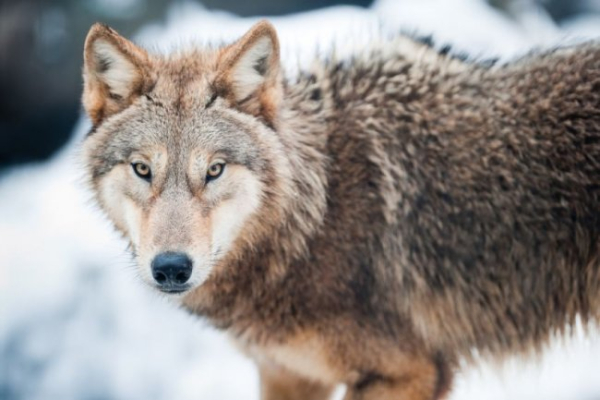
I have never heard of life smiling at wolves,
In vain do we love her, we are monogamous.
Here death has a beautiful wide grin
And healthy, strong teeth.
(V. Vysotsky “Hunting from Helicopters”)
It is he who comes at night and grabs by the side all the children who do not want to sleep.
It was he who ate Little Red Riding Hood and her grandmother, attempted to kill seven kids, three piglets and a bunny with the voice of N. Rumyantseva.
It was he who chased Russian coachmen in the dead of frosty nights and caused the greatest material damage to the shepherds.
It was he who “gave birth” to man’s best friend and his sworn enemy – the dog.
It was he who was respected and feared, worshipped and exterminated.
After all, he is a wolf – an animal without which it is difficult to imagine the life, mythology and folklore of the inhabitants of the Northern Hemisphere. Who is he – a “nature orderly” slandered by enemies or the most dangerous forest predator?
From the storehouse of folk wisdom:
• Don't put your finger in the wolf's mouth;
• Hungry like a wolf;
• Look like a wolf;
• Makes you howl like a wolf;
• No matter how much you feed a wolf, he still looks into the forest;
• A wolf is not beaten because he is gray, but because he ate a sheep;
• The wolf's legs feed him;
• This is not the first winter for the wolf;
• Homo Homini Lupus Est» (lat. “Man is a wolf to man”);
• The Tambov wolf is your comrade.
Whatever the facts and myths surrounding this character, the first impression of a wolf is almost the same for everyone: it is a sullen, wild, gray fellow with yellow, glowing eyes, howling at the moon, gathering in huge packs and tirelessly pursuing lonely travelers in the dark forest.
There are certainly facts underlying this idea, but the facts are either greatly exaggerated or incomplete. Let us begin to restore the truth in order.
Dark Forest
Yes, wolves love hidden wilderness, but they live not only in the forest (by the way, they avoid solid forest areas, where it is more difficult to get food). This predator is widespread from the tundra to the steppes and semi-deserts. It even rises to the mountains to a height of 3-4 thousand meters above sea level, which shepherds know very well.
Grayness
The grayness of a wolf is a very conditional category, and there are many variations here. Everything depends on the habitat. In the steppes and semi-deserts, wolves are reddish, in the tundra, on the contrary, they are very light, and in winter they are almost white.
By the way, the White Wolf (albino wolf) has long been considered a magical creature. He was called the “White Tsar” and was credited with power over other wolves. One of the stories from the Smolensk province said: “Here, white tsar, if you touch a man, he will touch him; but if you touch him, he will not touch either one.”
Howl at the Full Moon
In principle, the wolf does not care what phase of the moon is in the sky. On dark nights of the new moon, they howl no less, because these chilling melancholy melodies are not intended for the Earth's satellite, but for their “brothers”. In this way, predators transmit information about themselves, about their prey, about the presence of people and other wolf affairs. Although sometimes it seems that such “hawing” does more harm than good to the wolf. Hunters know very well that as soon as they start “calling” – that is, imitating a howl (even if ineptly), the most cautious pack will immediately give out and give itself away completely.
Huge flocks
Try to imagine a pack of wolves. Can you imagine it? Well, your opinion of wolf brotherhood is likely to be exaggerated. A pack of wolves rarely exceeds 10-12 individuals (the largest pack registered in the USSR consisted of 24 wolves, in Alaska – 36). After all, traditionally it consists of a wolf pair with a litter of yearlings plus the remaining and new single males from the previous year. In difficult years, packs sometimes unite to make hunting easier (in Kazakhstan, a similar “cooperative” of 42 wolves was observed).
Hatred of dogs
This is as true as the fact that the wolf was the ancestor of the domestic dog. Although there are some mysteries here too. In normal times, the “ancestor” boldly and skillfully kidnaps dogs almost from village yards, sometimes even in front of the hunters. However, during a raid, when the dogs are on their heels, the wolves do not even try to fight back and shamefully run away.
Exceptionally fresh meat diet
Wolves, of course, do not like carrion, but… hunger is not an aunt, and in severe winters one sometimes has to forget “aristocratic” habits. In addition, wolves happily consume berries, fruits, and in the southern regions they visit melon fields no less regularly than sheep pastures.
Voracity
And here the wolf's “merits” are often exaggerated. The hungriest wolf can eat no more than 10 kg of meat at a time, usually 2 kg are eaten, and the rest is saved for a rainy day. Although this is not a bad appetite.
Endurance
It's the pure truth. Both that “legs feed” and that the “gray brother” is tenacious. He can walk up to 60-80 km per night, run away with a sheep on his back, and go hungry for a long time. In the Yamal tundra, they observed how a wounded wolf lay in a shelter, without leaving the place and without hunting, for 17 (!) days. He lost weight, but when his wounds healed, he ran quite briskly.
“Wolf” laws
But this is something worth talking about separately…
Proverbs, sayings, tales and songs recreate in the eyes of a peaceful citizen the image of bloodthirsty, fierce “bandits” whose life is built exclusively on the “right of the strongest”. The position of a “murderer” and at the same time an “outcast”, constantly persecuted by people, the prevalence of force made the wolf almost a “totem” animal of the criminal world (let us also recall the expression “wolf ticket” – a symbol of political unreliability in Tsarist Russia).
Let's agree not to draw direct parallels between animals and humans. A wolf pack is, after all, a somewhat different “collective” than a human gang.
Firstly, as already mentioned, this is a family with several loser aliens.
Secondly, fights between wolves are extremely rare, mostly during the fight for a female. By the way, in zoos it was noticed that females not only did not allow a “modest” wolf to approach them, but also attacked him themselves. But as soon as a strong male attacked a female, she would roll over on her side, exposing her belly and expressing the most sincere “surrender” feelings. Well, just like Queen Brunhilda from the “Song of the Nibelungs”, who on her wedding night tied up and hung from the ceiling the suitors who were weaker than her!
Otherwise, the family life of wolves is more than peaceful. Wolves are mostly “monogamous” (scientifically – monogamous), their family pairs are quite constant. Wolf daddies are extremely patient – the cubs can safely pull the “father” by the tail and ears as much as they want. When the male returns from hunting, they pull his lips, thereby stimulating burping, which they happily feed on. The workers of the Moscow Zoo even have a joke: “The wolf loves his children so much that they make him sick.”
Of course, discipline is strict in the pack itself, but order is usually established without bloody clashes, but only through gestures of threat and submission (the best indicator of this is a raised or tucked tail). The leader is more than tolerant of “his own” and aggressively meets only “strangers”.
The duties during the hunt are also clearly divided: some wolves guard the prey in ambush, others drive it into this ambush. During the chase, some wolves run after the prey, some run across. If the chase is long, the tired lead hunters are replaced by “fresher” ones. If there is no discipline, there will be no pack, and without a pack, a successful hunt is impossible.
As for cannibalism, there is a grain of truth in it. There are frequent cases when wolves kill and eat weakened and wounded relatives. And in the same Moscow zoo they even observed how a mother gives the signal to deal with a frail and sickly wolf cub.
That's probably why there are so few weak wolves in nature.





